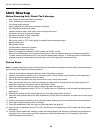
21
NS SPLIT INSTALLATION MANUAL
Leak Testing
The refrigeration line set must be pressurized and checked for leaks before purging and charging the unit. To pressurize
the line set, attach refrigerant gauges to the service ports and add an inert gas (nitrogen or dry carbon dioxide) until pres-
sure reaches 60 to 90 PSIG. Never use oxygen or acetylene to pressure test. Use an electronic leak detector or a good
quality bubble solution to detect leaks on all connections made in the eld. Check the service valve ports and stem for leaks
and all connections made in the eld. If a leak is found, repair it and repeat the above steps. For safety reasons do not pres-
surize the system above 150 psi. Purge pressure from line set. The system is now ready for evacuating and charging.
System Evacuation
Ensure that the line set and air coil are evacuated before opening service valves to the split unit. The line set must be
evacuated to at least 200 microns to remove the moisture and air that may still be in the line set and coil. Evacuate the sys-
tem through both service ports to prevent false readings on the gauge because of pressure drop through service ports.
Initial System Charge Calculation
The Envision unit comes with a factory pre-charge. This volume is not sufcient to run the system. Additional refrigerant
must be added for the lineset. This additional charge added to the factory pre-charge of the Envision unit should be esti-
mated using the following equation:
Addition to Factory Charge = (lineset length x oz. per ft) + (20 oz. for accumulator)
The lineset charge should be calculated by multiplying the length times 0.5 oz./ft for 3/8” liquid line and 1.0 oz/ft for 1/2”
liquid line in R-410A systems. The suction line will not hold ‘liquid’ and can be ignored for the calculation. This should result
in a slightly under-charged unit exhibiting low subcooling and high superheat. As charge is added, the subcooling should
rise and the superheat should fall until 8-16 degrees of superheat is reached when the TXV should be metering the system.
See operating details in the startup section of this manual for exact superheat and subcooling values.
Example: 038 with 40 foot of 3/8” liquid line.
Additional to be added = (40 ft x 0.5 oz./ft) + (20 oz. for accumulator)
= 40 oz.
Solution: 40 oz. should be added to the existing 56 oz. of factory charge as an initial charge.
Charging the System
Charge Method – After purging and evacuating the line set, fully open the service valves counterclockwise. Add R-410A
(liquid) into the liquid line service port until the pressure in the system reaches approximately 200 PSIG. Never add liquid
refrigerant into the suction side of a compressor. Start the unit and measure superheat and subcooling. Keep adding refrig-
erant until the unit meets the superheat and subcooling values on page 24.
Checking Superheat and Subcooling
Determining Superheat
Measure the temperature of the suction line at the point where the expansion valve bulb is clamped.
Determine the suction pressure in the suction line by attaching refrigeration gauges to the schrader connection on the
suction side of the compressor.
Convert the pressure obtained in Step 2 to the saturation temperature by using the R-410A Pressure/Temperature Con-
version Chart on page 23.
Subtract the temperature obtained in Step 3 from Step 1. The difference is the amount of superheat for the unit. Refer to
tables on page 24 for superheat ranges at specic entering water conditions.
Superheat Adjustment
TXV’s are factory set to a specic superheat; however, the superheat should be adjusted for the application. To adjust
the TXV to other superheat settings:
Remove the seal cap from the bottom of the valve.
Turn the adjustment screw clockwise to increase superheat and counterclockwise to decrease superheat. One complete
360° turn changes the superheat approximately 3-4°F, regardless of refrigerant type. You may need to allow as much as
30 minutes after the adjustment is made for the system to stabilize.
1.
2.
3.
4.
1.
2.
Refrigeration (continued)


















